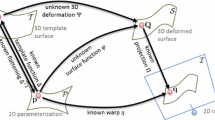Abstract
Recovering the shapes and motions of 3D objects from visual data is a primary goal of low and intermediate level vision. Despite the large body of work on 3D shape modeling and motion extraction, most existing techniques deal with simple shape primitives and rigid motion. Many natural objects, however, have shapes which cannot be described accurately in terms of simple shape primitives and their motions are often nonrigid. To deal with such complex motions, we need 3D models with broad geometric coverage and associated techniques for inferring 3D shape and nonrigid motion from noise-corrupted data.
Access this chapter
Tax calculation will be finalised at checkout
Purchases are for personal use only
Preview
Unable to display preview. Download preview PDF.
Similar content being viewed by others
References
A. Barr. Global and Local Deformations of Solid Primitives. Computer Graphics, 18:21–30, 1984.
D. Metaxas and D. Terzopoulos. Constrained Deformable Superquadrics and Nonrigid Motion Tracking. In IEEE Computer Vision and Pattern Recognition Conference (CVPR’91), Hawaii, 1991, to appear.
A. Pentland. Perceptual Organization and the Representation of Natural From. Artificial Intelligence, 28:293–331, 1986.
A. Pentland. Canonical Fitting of Deformable Part Models. In Sensing and Reconstruction of Three-Dimensional Objects and Scenes, Proc. SPIE 1260, B. Girod (ed.), pages 216-228, 1990.
M. Rioux and L. Cournoyer. The NRCC Three-Dimensional Image Data Files. Technical Report CNRC No 29077, National Research Council of Canada, 1988.
F. Solina and R. Bajcsy. Recovery of Parametric Models from Range Images: The Case for Superquadrics with Global Deformations. IEEE Trans. Pattern Analysis and Machine Intelligence, 12(2):131–146, 1990.
D. Terzopoulos and D. Metaxas. Dynamic 3D Models with Local and Global Deformations: Deformable Superquadrics. IEEE Trans. Pattern Analysis and Machine Intelligence, 1991, in press. See also Proc. Third International Conference on Computer Vision (ICCV’90), Osaka, Japan, Dec. 1990, pp. 606-615.
D. Terzopoulos, A. Witkin, and M. Kass. Constraints on Deformable Models: Recovering 3D Shape and Nonrigid motion. Artificial Intelligence, 36(1):91–123, 1988.
Author information
Authors and Affiliations
Editor information
Editors and Affiliations
Rights and permissions
Copyright information
© 1992 Springer Science+Business Media New York
About this chapter
Cite this chapter
Metaxas, D., Terzopoulos, D. (1992). Shape Representation and Recovery Using Deformable Superquadrics. In: Arcelli, C., Cordella, L.P., di Baja, G.S. (eds) Visual Form. Springer, Boston, MA. https://doi.org/10.1007/978-1-4899-0715-8_38
Download citation
DOI: https://doi.org/10.1007/978-1-4899-0715-8_38
Publisher Name: Springer, Boston, MA
Print ISBN: 978-1-4899-0717-2
Online ISBN: 978-1-4899-0715-8
eBook Packages: Springer Book Archive




